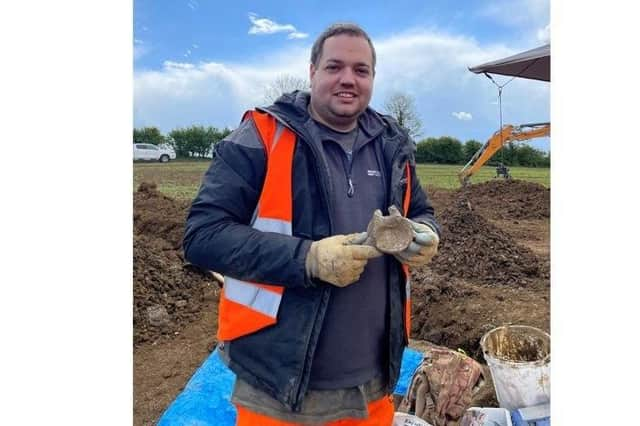Huge dinosaur skeleton found in Cambridgeshire could be a new species


Jamie Jordan was called to investigate after a large number of bones were found in a farmer’s field, in Cambridgeshire - which he believes could belong to a new specimen of Plesiosaur.
It took Jamie, his partner Sarah Moore and a team of volunteers five weeks to excavate the site. They have recovered between 60 and 70 per cent of the skeleton belonging to the prehistoric monster, which would have measured between seven and nine metres in length.
Advertisement
Hide AdAdvertisement
Hide Ad“This is a really unusual find,” said Jamie, who runs Fossils Galore museum and educational centre in March, Cambridgeshire.
“This creature would have been swimming in the subtropical sea during the late Jurassic period, around 145 million years ago. For it to be brought up to the surface by the cultivation of the land, through ploughing, is very unusual, as it would have been in the bedrock.
“I initially thought it was a Pliosaur, but further investigations have shown it to be a Plesiosaur – the type of creature you associate with the Loch Ness Monster.
“From our research to date, it doesn’t seem to match any other specimen, so could possibly be a new one, which is very exciting.’
Advertisement
Hide AdAdvertisement
Hide AdJamie was called to the site, located near the A14, by a metal detectorist after he found the bones while walking a farmer’s field in early 2020. He began his excavations shortly after but had to put the dig on hold due to the Covid pandemic, only re-starting it in May, this year.
“With there being so many bones on the surface, brought up by years of ploughing, it became clear that there was definitely more to find,’ adds Jamie.
“It took several days, I had to call on all my expertise, but we managed to hit upon the right spot in the end.
“Because of the agricultural work, some of the bones have been bashed about a bit, while others have been bleached by the sun, but those in situ are still in very good condition.
Advertisement
Hide AdAdvertisement
Hide Ad“Although we are still in the process of cleaning and researching the skeleton we’ve already made some exciting discoveries, including signs of healing from old injuries, predation marks and evidence of other animals such as sharks, who would have been savaging it after death.”
From the size and the structure of the bones, Jamie says this particular specimen was a juvenile when it died and would mainly have fed on fish, squid and ammonites.
Other items including teeth belonging to sharks, pterosaurs and Pliosaurs were also found at the dig site.
The Plesiosaur skeleton has been named Ella, after the landowner’s daughter. Jamie estimates it will take around four years to fully clean, preserve and research it.
Advertisement
Hide AdAdvertisement
Hide AdOnce the task is complete the skeleton will be laid out on display in the Fossils Galore Museum for everyone to see, alongside the skeleton of Indie, the 132-million-year-old Iguanodon, which Jamie and Sarah discovered in a Surrey quarry in 2017.
Fossils Galore is solely run by volunteers and Jamie is always looking for more people to get involved.
To find out more contact Fossils Galore on 01354 278089 or at www.fossilsgalore.com